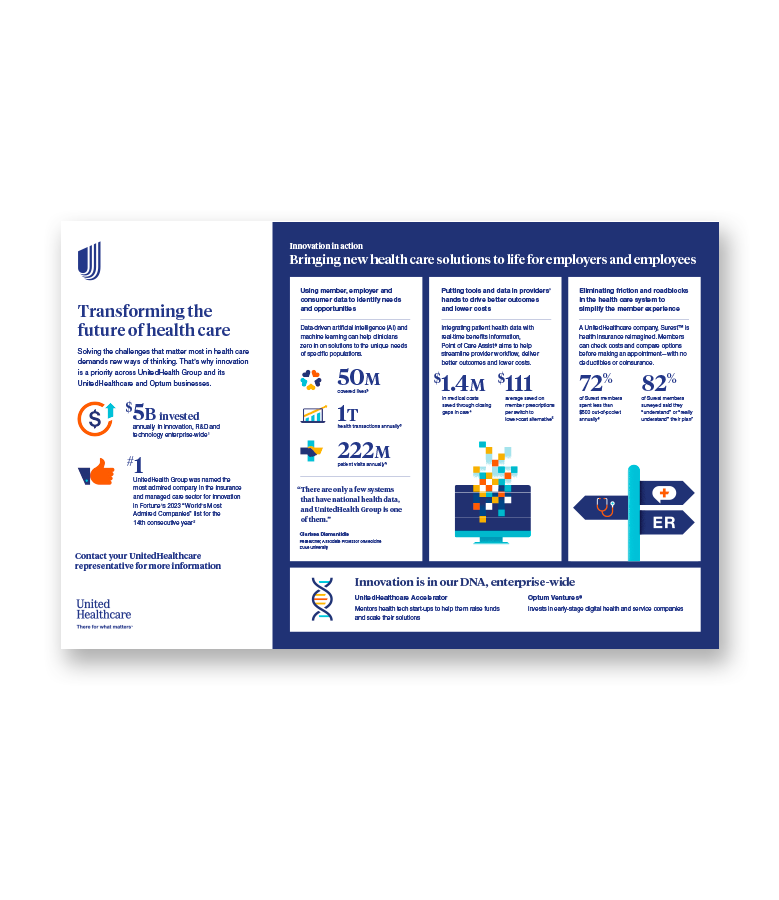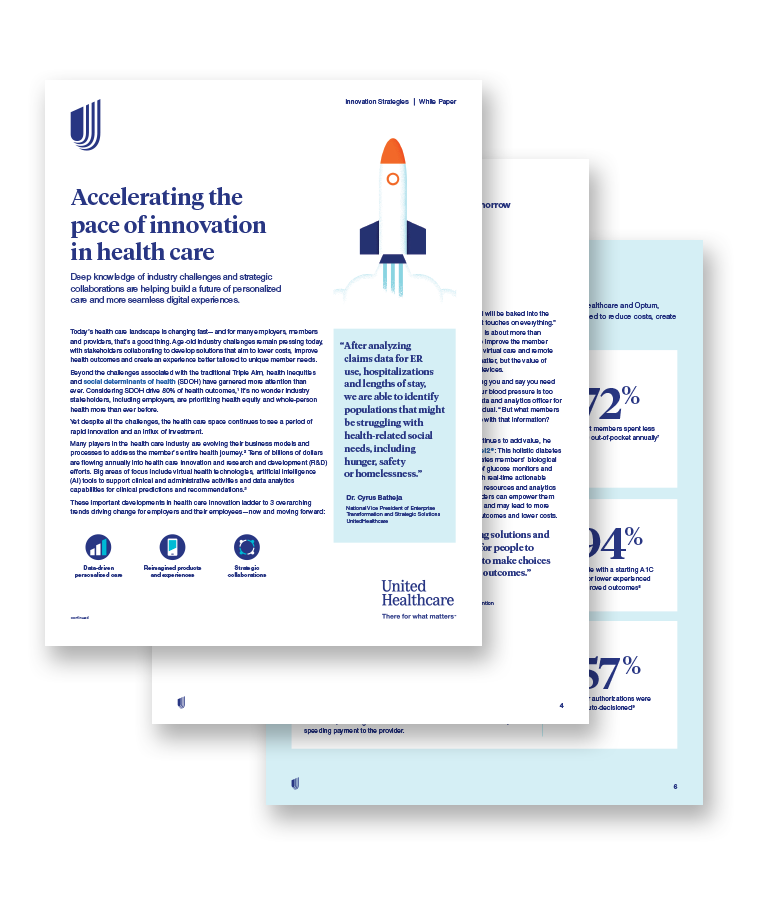Accelerating the pace of innovation in health care
Deep knowledge of industry challenges and strategic collaborations are helping build a future of personalized care and more seamless digital experiences.
Today’s health care landscape is changing fast — and for many employers, members and providers, that’s a good thing. Age-old industry challenges remain pressing today, with stakeholders collaborating to develop solutions that aim to lower costs, improve health outcomes and create an experience better tailored to unique member needs.
Beyond the challenges associated with the traditional Triple Aim, health inequities and social determinants of health (SDOH) have garnered more attention than ever. Considering SDOH drive 80% of health outcomes,1 it’s no wonder industry stakeholders, including employers, are prioritizing health equity and whole-person health more than ever before.
Yet despite all the challenges, the health care space continues to see a period of rapid innovation and an influx of investment. Many players in the health care industry are evolving their business models and processes to address the member’s entire health journey.2 Tens of billions of dollars are flowing annually into health care innovation and research and development (R&D) efforts. Big areas of focus include virtual health technologies, artificial intelligence (AI) tools to support clinical and administrative activities and data analytics capabilities for clinical predictions and recommendations.3
These important developments in health care innovation ladder to 3 overarching trends driving change for employers and their employees — now and moving forward:
Transforming the future of health care


A one-pager on innovation
An overview of the areas UnitedHealthcare is focused on driving innovation to help address some of health care’s biggest challenges and transform the future of health care.
(Continue reading below for the full text of the innovation white paper)
Industry complexity calls for innovation
The health care industry faces unique innovation challenges stemming from its complexity. For members to realize increased value, upstream stakeholders — providers, payers, health systems and health plans — need to be in sync, says John League, managing director of digital health research for Advisory Board. The problem is that "most of their incentives do not push them in that direction," he says. "There are short-term advantages to not being in sync, so everybody ends up with their own system, siloed."
Fragmentation, in other words, is a big obstacle to innovation. To overcome that hurdle — to be able to successfully design and build, or invest in, solutions that can scale — requires both knowledge and bandwidth. "You need deep industry knowledge, balanced with curiosity and flexibility, to scale things in a meaningful way," says Jennifer Pinerski, senior vice president of commercial reinvention for UnitedHealthcare Employer & Individual.
"You need to understand the complex aspects of health care to innovate and cultivate the right solutions for driving value."
With an annual investment of over $5B in innovation, R&D and technology,4 UnitedHealth Group, the parent company of UnitedHealthcare, is committed to building a better health care system. The goal is nothing less than health care that is more integrated, equitable and affordable for everyone. At the center of the innovation ecosystem? The member. When it comes to innovation, the goal is to address the pain points within the member experience and develop targeted solutions.
Personalized care grounded in data
Members increasingly expect providers to personalize their experience — to recognize them at an individual level across the spectrum of touchpoints, as is often common in other industries.5 More personalized products, services and experiences are emerging with the help of AI and data science, precision medicine and multi-omics (genomics, proteomics and others), as well as redesigned health plans, networks and pharmacy services.
Personalized health care can mean many different things — everything from providers delivering care virtually to wearable devices enabling individualized management of chronic diseases such as diabetes. But when Jaime Murillo thinks about personalized care, he thinks about data. As senior vice president and chief medical officer of enterprise strategy & innovation for UnitedHealth Group, Murillo has an up-close view on how emerging data-driven AI and machine learning (ML) technologies can help clinicians zero in on the unique needs of specific member populations.
"No two human beings are the same, but too often they are treated the same in a medical setting," Murillo says. He sees a future where clinicians have more seamless access to that draws on various data streams — the patient’s own medical history, but also relevant demographic and SDOH-related data — to better inform next-best actions.
Consider the pharmacy experience for members, as well as physicians, care providers and pharmacists. There are tools informed by data that help clinicians direct members to available lower-cost drugs and proactively push savings alerts to members so they’re aware of opportunities to save on prescriptions.
"Members deserve to have this kind of transparency in savings opportunities," says Susan Maddux, chief pharmacy officer for UnitedHealthcare Employer & Individual. "It’s a good example of how innovation efforts can drive costs out of the system while improving the member experience. Affordability and improving that experience are core goals for us."
The impact of data and personalization is also seen in the provider’s office. Real-time access to improved data about the quality of network specialists, for example, could help reduce overall costs and suggest for members a care regimen more tailored to their unique needs.
"Imagine if a primary care physician could understand the quality of a specialist not by word of mouth but based on data detailing a lack of patient readmissions," says Dr. Gerald Hautman, chief medical officer for UnitedHealthcare National Accounts.
"We can help providers better support members by providing this kind of information so they can adjust their decision-making based on potential impacts on each patient sitting before them."
Reimagined products and experiences to help meet the needs of tomorrow
To better meet evolving employer, provider and employee needs, the health care industry must think bigger and bring new or revamped products and plans to market. UnitedHealthcare listens to employees and employers, as well as brokers and consultants, and uses that insight to enhance its offerings, reduce friction points and support people and communities to foster better health at lower costs.
With employers and employees facing more complexity in the health system than ever before, offering better resources for navigating that complexity is critical. Surest™, a UnitedHealthcare company, redesigned health insurance to give members power over their health experience. Members can search for costs and coverage on the Surest app or website and choose from high-value providers before making an appointment, without the obstacles of a deductible or coinsurance.
UnitedHealthcare is also making investments to enhance its Advocacy program to deliver more thoughtful, human-centered interactions, proactive guidance and coordinated connections across an employee’s health care experience. Practically, that looks like everything from better integrations of medical data and benefits so advocates can offer timely recommendations based on a member’s specific needs to a concierge-type service for members who are dealing with unique health situations.
Digital advancements will continue to play a foundational role in reimagining products and experiences. Historically, organizations may have thought of "digital health care" as distinct from the broader health care experience. But just as "e-commerce" has become a redundant term as innovation investments continue to bear fruit, "digital health care" is on its way to just being "health care," League says.
"That’s where we’re heading; digital will be baked into the health care experience," he says. "It touches on everything." The future of digital, in other words, is about more than specific tools and platforms used to improve the member experience: apps, member portals, virtual care and remote monitoring devices. These things matter, but the value of digital goes beyond channels and devices.
"It’s great that these devices will ping you and say you need to stand, or you need to walk, or your blood pressure is too high," says Craig Kurtzweil, chief data and analytics officer for UnitedHealthcare Employer & Individual. "But what members really struggle with is, ‘What do I do with that information? What does it mean?"
This is where UnitedHealthcare continues to add value, he adds. Consider the example of Level2®: This holistic diabetes accountable care organization updates members’ biological data dynamically, though the use of glucose monitors and activity trackers, providing them with real-time actionable feedback. Putting data-driven tools, resources and analytics in the hands of members and providers can empower them to be more proactive with their care and may lead to more seamless experiences, improved outcomes and lower costs.
"Innovation means finding solutions and ways that make it easier for people to navigate health care and to make choices that lead to better health outcomes."
Strategic collaboration powers innovation
True innovation doesn’t happen in silos — key stakeholders need to collaborate to surface important problems and design viable solutions. Employers, academic institutions, provider systems, policy leaders, nonprofits and other organizations can together develop an innovation agenda that advances the industry through solutions that bring value for providers, employers and their employees.
While Optum teams include doctors, nurses, pharmacists and clinicians — along with data scientists and health care economists, among other experts — the organization collaborates with UnitedHealthcare to help ensure solutions are designed to solve challenges employers are facing today.
Given the complexity of health care delivery and systems, strategic collaborations to drive innovation take many forms. UnitedHealth Group collaborates with stakeholders both inside and outside the organization to advance its innovation agenda:
- UnitedHealth Group’s innovation ecosystem has a big emphasis on nurturing promising startups, through direct investments via Optum Ventures, a venture capital fund with more than $1B in assets under management
- The UnitedHealthcare Accelerator program focuses on helping early-stage startups foster growth through mentorship and investing, enabling pathways to commercialization
- The UHC Hub™ brings together a curated network of vendors, which complement UnitedHealthcare solutions, into a single dashboard for a simpler and more connected experience for employers and employees
As senior director of innovation at UnitedHealthcare, Clayton Burke oversees the Accelerator program. Cross-functional collaboration is built into its DNA. The mentors, events and curricula it offers to startups bring people together from across UnitedHealthcare, UnitedHealth Group and from external collaborators to help solve important problems.
The immediate goal is to help startups bolster their businesses through the network and opportunities offered by the program. But the program also plays an important role in reinforcing the culture of, and commitment to, innovation at UnitedHealthcare by providing exposure to new ways of thinking and risk-taking.
"Our program is really focused on how we, as a health care leader, can support and accelerate the pace of digital health innovation for the ecosystem at-large. The UnitedHealthcare Accelerator serves as an important channel for cultivating potential partners that deeply understand and can deploy solutions that reflect the needs of our enterprise and the diverse populations we serve," Burke says.
In health care, a common obstacle to successful innovation — meaning new products and services that work at scale — is the fragmented nature of the sector. But the integrated nature of UnitedHealth Group brings together a payer (UnitedHealthcare), a technology company (Optum) and a provider (Optum Care) under one roof as innovation collaborators. That matters, Burke says, because it sets the stage for strategic collaborations. "To bring together the experience and expertise across our entire organization is incredibly impactful and means we have a greater chance of being able to actually scale things in a meaningful way," he says.
"The only way you’ll successfully innovate is if you go out there and try. A lot of companies shy away from what looks tough. But you have to be fearless to attack these problems. You can’t be afraid of failing."
Innovation in action
The following programs are examples of UnitedHealth Group and its companies, UnitedHealthcare and Optum, collaborating inside and outside the organization to advance an innovation agenda designed to reduce costs, create a stronger member experience and improve health outcomes.
